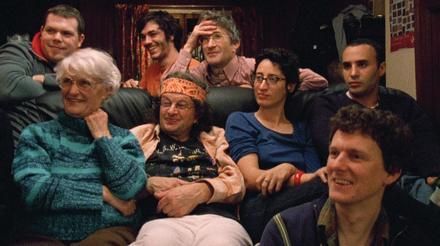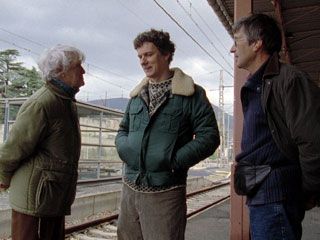They say the canary always sings the same song. Spielberg makes films about the redemption of the patriarch. Aronofsky makes films about obsession and ritual. Kubrick made films about the inherent evils of human nature. Michel Gondry meanwhile makes films about the families we are born into and the families we choose, an idea that he explores more deeply and more openly in his latest documentary film, The Thorn in The Heart than he ever has before. Read on for the full review.
The idea of family and belonging runs deep in Gondry’s oeuvre. His first film, the underrated Human Nature dealt with a cast of characters all trying to find a home: the scientist who shaves her entire body every day so that people won’t call her a freak, the pseudo-caveman who learns manners better than a cotillion instructor, the dead love interest who tells his rambling story to no one in the afterlife, just trying to make sense of it all. In Eternal Sunshine of The Spotless Mind and The Science of Sleep he explored the ways in which pain defines the love we feel for our significant others. Both Dave Chappelle’s Block Party and Be Kind, Rewind focused intensely on the feeling of kinship in low income communities where far too many families are “broken.” Now, in The Thorn in The Heart he digs right down to the epicenter of this fascination – his own relatives.
Running a scant 86 minutes including credits, The Thorn in The Heart tells the life story of Gondry’s aunt Suzette. And sometimes the story of her openly gay son, Jean-Yves. And sometimes the story of Gondry himself. But then sometimes it’s just about grade schoolers learning about movie magic.
Focus and narrative cohesion have rarely been strong points for Gondry and this film is certainly no exception. We take detour after detour, learning bits and pieces about the family history, personal predilections, and extended reenactments of almost excessively mundane moments. Most of these vignettes are quite fascinating, but at the same time, too many of them fail to tie together. I don’t doubt that if Gondry were to visit a schoolyard he would bring along enough blue screen equipment to make a short film where he makes the class invisible, but I don’t quite know why this was included in the feature.
Make no mistake, however, this is not just a film made of random Gondry home movies. It is an expert piece of fillmaking. An experiment in subtle style, and intense mood. There is a palpitating ache underneath it all and a great beautiful sadness that Gondry captures. A mood which carries the whole piece, accented by a mesmerizing score.
More than even Be Kind, Rewind, The Thorn in The Heart is about the filmmaking process. Gondry goes to great lengths to remind you that though you are watching a “non-fiction” film, you are still very much at the mercy of the editor’s view of the “truth.” He narrates scenes, describing how he set up this moment of “reality”. He cuts away to a toy train set to establish location changes. He even uses animation here and there when live action footage would have easily sufficed.. The narrative moves forward in jaunts as little bits and pieces flash up on screen, explaining how each effect was achieved. Gondry’s point seems to be that all of these moments, all of the pain inflicted back and forth, it’s all misremembered, sometimes on purpose. In effect, Gondry is using the lens of the camera to mimic the lens of memory allowing us into the inner recesses of his family members minds so that we might look more deeply into our own.
I do not think it is an insult to say that during much of the film’s run time I found myself focusing not on the countryside of France, but upon my own upbringing in the San Fernando Valley. Each complicated relationship turn between Suzette and Jean-Yves recalled a different moment of my own adolescence. Their triumphs and failures reflected and complimented my own. Their turmoil took me back to dark days and gave me a new angle with which to examine them, and their true, if fractured, love for one another gave me hope for my own past and future. And because of this, The Thorn in The Heart is perhaps the best film Gondry has made since Eternal Sunshine. It is not a masterwork and not a visual smorgasbord like most of his films, but it digs under your skin and lives there for weeks. And that, is perhaps the best magic trick of all.
THE DVD:
Even though The Thorn in The Heart barely made a blip on the box office and mainstream critical radar, Oscilloscope has released a stacked DVD full of insightful bonus features all housed within a very attractive and well-designed fold-out package. In fact, this might well be the best DVD packaging I have seen in recent memory, (the only other contender would be the intentionally hideous Xavier: Renegade Angel packaging).
And the features on the disc are just as good as their presentation.
There is a 15-minute long documentary on the history of the Harkis, Arab forces who fought on the side of France against other Algerians. This extra is pretty much required viewing for any young American fan trying to understand the movie. It’s a crash course in French history with Algeria. Not only did it assist in my understanding of the movie, it also helped me understand Camus’ The Stranger a little bit better. It reuses footage from the film but it is quite powerful and very informative.
On the opposite end of the spectrum is “Techno Suzette.” A bizarre and absurd feature made up of footage taken by suzette when she mistook a film camera for a still camera. It’s kind of fun and psychedelic, but it doesn’t amount to much beyond, a you-had-to-be-there moment.
Continuing along this path of oddball extras is “Calendars Doodled” which is about 2 minutes of close up footage of monthly calendars drawn on by children. I suppose this type of thing holds some anthropological value, but it’s not exactly what I would call entertaining. That said, it has some really cool background music.
Additionally there is a collection of stop motion animated scenes by Valerie Pirson. Most of these were cut from the final film, but are reassembled as a 2 minute clip here. Each and every one of these short clips is great. The animation is vivid, inventive, and fluid. While these animations were not make by Gondry himself, they do display the same type of visual ingenuity that is largely absent for this more restrained effort. And while the film is strong in its minimalism, it is very nice to see this stuff as an extra.
But not to be outdone by a collaborator, Gondry also includes his video for Charlotte Gainsbourg’s “Little Monsters.” I will always be a bigger fan of her father’s music, but this is one of Charlotte’s best songs. And the visuals are typical Gondry genius. There are 3 DVD collections of his videos for a reason.
The final two features are Q&A sessions with Gondry at SXSW. All together this is about 35 minutes of discussion with Gondry. Frankly, these features would have been better with subtitles. Gondry’s English has certainly improved since I interviewed him for The Science of Sleep but he still has a very thick accent and a tendency to mumble. His wit is razor sharp and his comments are insightful, so it’s worth trudging through because there are diamonds to be found, but I really, really wish there were subs on this too.
CONCLUSION:
Though I would hesitate to say that I enjoyed The Thorn in the Heart, it is impossible for me not to admire it. It sees very deeply into the human condition and made me reconsider my own thoughts on my childhood. If you’re not an avid fan of documentaries, you will likely be bored, but if you’re willing to put in the effort, it will pay dividends.
Meanwhile, the DVD is a mixture of typical Gondry effervescence and serious historical analysis. I literally learned things from this disc, which is a rare feat indeed. If the interviews featured subtitles it would be an even better set. Also, great packaging.
The Film: 8.7/10
The DVD: 9.0/10


